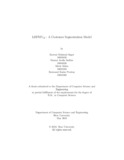| dc.contributor.advisor | Zaman, Shakila | |
| dc.contributor.advisor | Noor, Jannatun | |
| dc.contributor.author | Sagor, Kawsar Mahmud | |
| dc.contributor.author | Sadhin, Masrur Arefin | |
| dc.contributor.author | Jahan, Ishrat | |
| dc.contributor.author | Prottay, Rezwanul Karim | |
| dc.date.accessioned | 2023-12-20T04:16:01Z | |
| dc.date.available | 2023-12-20T04:16:01Z | |
| dc.date.copyright | 2023 | |
| dc.date.issued | 2023-05 | |
| dc.identifier.other | ID 18101638 | |
| dc.identifier.other | ID 18101626 | |
| dc.identifier.other | ID 18101310 | |
| dc.identifier.other | ID 18101308 | |
| dc.identifier.uri | http://hdl.handle.net/10361/22010 | |
| dc.description | This thesis is submitted in partial fulfillment of the requirements for the degree of Bachelor of Science in Computer Science, 2023. | en_US |
| dc.description | Cataloged from PDF version of thesis. | |
| dc.description | Includes bibliographical references (pages 35-39). | |
| dc.description.abstract | Customer segmentation is a big part of the superstore industry. Traditionally,
the RFM model has been used to segment customers to maximize profit.
This work proposes a new customer segmentation named LRFMVD based
on RFM and LRFMV models in hopes of providing a more sure-fire way of
segmenting customers. The k-means clustering method will be used for the
proposed model. The clusters created by K-means are then analyzed using
the LRFMVD model to find a correlation between profit and volume. Many
works have been done previously on customer segmentation for maximizing
profit, but none of those were able to show a straightforward representation of
profit, volume, and discounts on products. Unsupervised learning was used to
investigate the correlations between volume, discount, and profit. Customers
are then segmented using the Customer Classification Matrix, which looks
at the properties of all clusters. The L, R, F, M, VD parameters’ values are
compared to the cluster mean values, and based on whether these values are
higher or lower than the average, customers are segmented. Comparisons
among the three models reveal that the latter provides more profit per head
than the other two, and is able to identify customers who cause superstores
to lose money or make a loss. | en_US |
| dc.description.statementofresponsibility | Kawsar Mahmud Sagor | |
| dc.description.statementofresponsibility | Masrur Arefin Sadhin | |
| dc.description.statementofresponsibility | Ishrat Jahan | |
| dc.description.statementofresponsibility | Rezwanul Karim Prottay | |
| dc.format.extent | 39 pages | |
| dc.language.iso | en | en_US |
| dc.publisher | Brac University | en_US |
| dc.rights | Brac University theses are protected by copyright. They may be viewed from this source for any purpose, but reproduction or distribution in any format is prohibited without written permission. | |
| dc.subject | Volume | en_US |
| dc.subject | Silhouette | en_US |
| dc.subject | Elbow | en_US |
| dc.subject | RFM analysis | en_US |
| dc.subject | LRFMV and LRFMVD analysis | en_US |
| dc.subject | K- means | en_US |
| dc.subject.lcsh | Customer relations--Management--Data processing | |
| dc.title | LRFMVD : a customer segmentation model | en_US |
| dc.type | Thesis | en_US |
| dc.contributor.department | Department of Computer Science and Engineering, Brac University | |
| dc.description.degree | B.Sc. in Computer Science and Engineering | |

